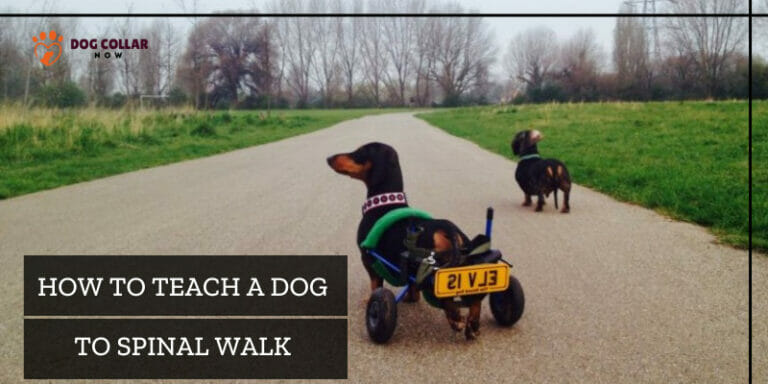Can A Dog Slip Out Of A Martingale Collar – All You Need To Know

When it comes to keeping your furry friend safe and under control, choosing a suitable collar is crucial. But can a dog slip out of a martingale collar?
As a dog owner, you want to keep your furry friend safe and secure when walking. However, some dogs tend to pull on the leash or even back out of their collar, which can be dangerous in certain situations.
A well-fitted martingale dog collar typically prevents dogs from escaping, but proper adjustment and supervision are necessary to ensure security.
Now, we’ll explore how these collars work, their advantages and disadvantages, and tips for preventing your pup from slipping out of their collar while keeping them comfortable and happy on walks.
Can A Dog Slip Out Of A Martingale Collar – Secure Your Pup
Martingale collars are designed to be safer than traditional flat collars or choke chain collars. They feature a loop that tightens when your dog pulls, preventing them from slipping out of the collar and escaping.
However, some people still wonder if their dog can slip out of a martingale collar.
While it’s possible for a dog to slip out of any type of collar, the design of a properly fitted martingale collar makes this much less likely. When worn correctly, the tightening loop will prevent the collar from sliding over your dog’s head or ears.
That said, it’s essential to make sure you’re using the right size and fit for your pup. A loose-fitting martingale can still allow dogs to back out of their collars or slip free during walks.
Additionally, it’s essential to supervise your pup when they wear any type of collar and never leave them unattended while wearing one.
This will help them stay safe and secure on walks without risking injury or escape attempts.
While no collar is 100% foolproof against escape artists or accidental slips, choosing a high-quality martingale with proper sizing and supervision can greatly reduce these risks for your furry friend.
How Does A Martingale Collar Work?
Here is a guide on how a martingale collar works:
- Martingale collars are designed to prevent dogs from loosening out of their collars while offering a humane way to correct pulling on the leash.
- They consist of two loops: a larger loop that fits loosely around the dog’s neck and a smaller loop connected by a D-ring.
- Attach the leash to the D-ring on the smaller loop.
- When tension is applied by pulling on the leash, the smaller loop gently tightens, preventing the collar from slipping off.
- The tightening is sufficient to ensure a secure fit, but not to the point of choking or harming the dog.
- This creates a controlled amount of tension that serves as a gentle reminder for the dog to avoid pulling.
- The martingale collar provides an effective and safe solution for dogs prone to backing out of flat collars or pulling excessively.
- It keeps the dog safe and secure while giving the handler better control during walks without causing discomfort or harm.
By following these steps and properly fitting the martingale collar. You can effectively control your dog’s movements while providing a comfortable and safe walking experience.
4 Reasons To Use A Martingale Collar For Your Dog
Martingale collars are a great option for dog owners who want more control over their pet’s behavior without resorting to harsh methods. Here are four reasons why you should consider using one on your furry friend:
- Martingale collars offer increased safety compared to traditional flat collars. Dogs can easily slip out of a collar if they pull too hard or become scared and try to back out of it. However, the design of a martingale collar prevents this from happening by tightening around the neck when pressure is applied, keeping your dog securely in place.
- These collars are especially useful for dogs who tend to pull on the leash during walks. The gentle tightening action helps discourage pulling while still allowing for comfortable breathing and movement.
- Martingales provide an excellent alternative to chain choke collars that may cause discomfort or injury when used improperly. Instead of causing pain or choking your dog into obedience. Martingales work with your pup’s natural instincts by providing just enough resistance to encourage good behavior.
- Use Martingales is that they come in various materials and styles so you can find one that suits both your and your pet’s tastes! Whether you prefer classic leather or colorful nylon webbing designs; there’s something out there for everyone!
Stay Safe With Our No Slip Dog Collars
When it comes to keeping your furry friend safe, one of the most important things to consider is their collar. Regular flat collars can be easily slipped out of my dogs who pull or back out of their collar.
This can lead to dangerous situations where your dog may run off and become lost or get into an accident.
That’s where a no-slip dog collar comes in. Specifically designed with safety in mind, these collars are perfect for dogs who tend to slip out of traditional collars.
No slip collars work similarly to martingale collars by tightening when your dog pulls, but they also have a locking mechanism that prevents them from expanding too much and slipping over your dog’s head.
With a no-slip collar on your dog, you won’t have to worry about them escaping or getting into danger while on walks or outings.
They’ll stay securely attached to the leash at all times, giving you peace of mind and allowing you both to enjoy each other’s company without any stress or anxiety.
Investing in a high-quality no slip collar for your pup is essential if you want them to stay safe and secure while exploring the world around them.
Are There Any Disadvantages To Using A Martingale Collar On A Dog?
While martingale collars can be a great option for many dogs, they are not without their disadvantages.
- One potential downside of using a martingale collar is that they can still apply pressure to your dog’s neck if they pull too hard. This can cause discomfort or even injury over time.
- Additionally, some dogs may not respond well to the sensation of the collar tightening around their neck when they pull the leash. In these cases, a flat collar or harness may be a better choice.
- Another consideration is that while martingale collars are designed to prevent your dog from sliding off out of their collar, it is still possible for them to do so in certain situations – particularly if the collar is not adjusted properly or if your dog has an unusually shaped head or neck.
- Some owners may find martingale collars less convenient than other types of collars because they require more adjustments and aren’t always as easy to put on and take off quickly
While there are some downsides to using a martingale collar on your dog, many owners find them to be effective at keeping their pets safe and secure during walks.
How Are Martingale Collars Different From Choke Collars?
Choke Collar:
- Choke collars tighten around a dog’s neck when the leash is pulled, while martingale collars do not have a tightening mechanism.
- Choke collars consist of an unbroken loop of chain, whereas martingale collars have two loops connected by a length of material.
Martingale Collar:
- The larger loop of a martingale collar fits around the dog’s neck, while the smaller loop prevents the collar from slipping off.
- Martingale collars only gently tighten to prevent dogs from slipping out, whereas choke collars can constrict significantly as pressure increases.
- Martingale collars offer safer control by avoiding airflow and blood circulation restriction when properly used.
- Martingale collars provide better control over dogs without causing physical harm or pain during walks or training sessions.
Find The Best martingale Collar for Large Dogs?
Tell us your dog’s breed and neck size, and we’ll help you find martingale collar on Amazon!
How Can I Prevent My Dog From Slipping Out Of His Martingale Collar?
If you’re worried about your dog slipping out of its martingale collar, there are a few things you can do to prevent it.
- Firstly, make sure the collar is fitted correctly. The martingale collar should be snug around your dog’s neck but not so tight that it can’t breathe or move freely. You should be able to fit two fingers between the collar and your dog’s neck.
- Secondly, use a leash that attaches to both the D-ring and the chain loop of the martingale collar. This will ensure that if your dog pulls or tries to back out of their collar, the chain loop will tighten and prevent them from escaping.
- Thirdly, keep an eye on your dog when they’re wearing their martingale collar. If you notice any signs that they might be trying to slip out of it (such as excessive scratching or rubbing), adjust the fit or switch to a flat buckle collar instead.
Remember that no collar is foolproof – even a well-fitted martingale may not be enough to stop some dogs from slipping out of their collars if they want to! Always supervise your dog when outside and consider using additional safety measures such as microchipping or GPS tracking devices in case they escape.
Conclusion
The martingale collar is a safe and effective option for keeping dogs secure during walks. While there are minor drawbacks, its advantages far outweigh them. A properly fitted martingale collar prevents slipping and gently discourages leash pulling. Invest in a high-quality collar, provide training, and you and your dog will benefit from its reliable control.
FAQs:
Are martingale collars safe for dogs that pull?
Yes, martingale collars are generally considered safe for dogs that pull. They provide a controlled correction and prevent slipping, promoting better leash manners without causing harm or discomfort to the dog.
What collar can a dog not slip out of?
A martingale collar is designed to prevent dogs from slipping out of their collar, providing a secure fit during walks and training sessions.
Can dogs wear martingale collars all time?
No, dogs should not wear martingale collars all the time. Martingale collars are specifically designed for use during walks and training sessions. Removing the collar when the dog is unsupervised or resting is recommended to ensure their comfort and safety.
Is a martingale collar better than a harness?
The comparison between a martingale collar and a harness depends on the individual dog’s needs and behavior. Each has its advantages and considerations.
How do you walk a dog with a martingale collar?
Attach the leash to the D-ring on the smaller loop when walking a dog with a martingale collar, ensuring it is properly fitted around the dog’s neck. Use gentle leash control and guide to discourage pulling while maintaining a secure and comfortable fit.






